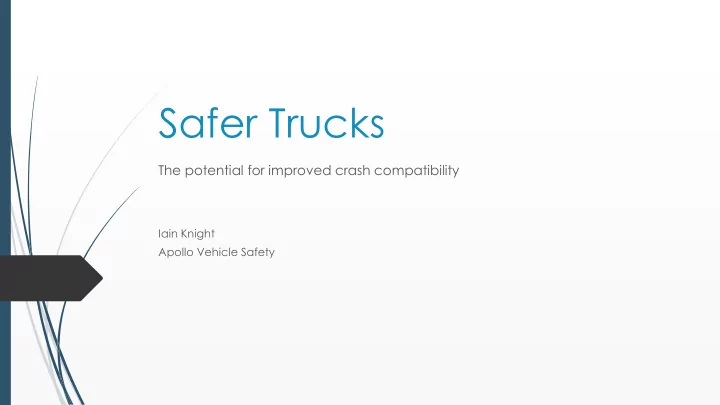

Safer Trucks The potential for improved crash compatibility Iain Knight Apollo Vehicle Safety
Truck Safety in context In 2013 4,021 Fatalities from accidents • involving HGV: Source CARE/Road Safety Observatory 50% car occupants, 21% VRU, 15% truck • occupants Within this, frequency of car to truck head- • on collisions is falling, progress slowing Suggestion that fatal and serious cases • falling less quickly than slight injury cases (Source: GB National Accident Database Stats 19) 40,0% R² = 0,4956 Expectation would have been for • Proportion of all casualties 35,0% 30,0% reducing severity after introduction of 25,0% Front Underrun Protection in 2003 20,0% R² = 0,3337 15,0% 10,0% 5,0% 0,0% 2004 2006 2008 2010 2012 2014 2016 Year of crash Fatal % KSI% Poly. (Fatal %) Poly. (KSI%)
Crashworthy design of cars
Crashworthy design of cars Good Structural Interaction Poor Structural Interaction
Car to truck collisions: Structural Interaction
Solving the problem - Underrun protection Sufficient strength • Good structural interaction • Horizontal • Vertical • Energy Absorption •
The Opportunity of additional length Move FUP away from chassis & other stiff components – better interaction Allow controlled deformation over a longer distance – energy absorption Potential to improve direct vision of pedestrians Potential for preventing pedestrian run-over by deflection
Passive Pedestrian Protection • Potential to adapt or extend UNECE R127 • Requires relative small amount of soft structure across the front of the vehicle • Head-Injuries dominant with flat front but may change
Barriers to overcome (FUP) UNECE R93 could be a constraint Requirement for full width coverage combined with manoeuvrability requirements suggest curved or angled FUP Current test would not work well for curved FUP Curved FUP may have some structural interaction risks
Options for consideration (FUP) Revised Quasi-Static test No Curved FUP, limiting length Minimum energy absorbed Design requirements controlling structural interaction Deformation Force (kN) (mm) Upper Lower 0 50 Introduce dynamic test using 25 250 50 50 254 175 progressive deformable barrier 400 300 175 400 300 175 850 300 175 Max acceleration criteria Design requirements controlling structural interaction Deformation length Proposed test speed Length extension (mm) available (mm) (km/h) 0-200 200-400 70 201-400 400-600 80 401-600 600-800 85 601-800 800-1000 90
Conclusions Fatalities from HGV collisions reducing but still significant Car occupants most frequently killed, followed by vulnerable road users Deaths from head-on collisions remain a problem despite legislation requiring FUP. Improvements are feasible: Structural interaction Energy absorption Permitting additional length provides an opportunity for improvement Car occupants & Front Underrun protection Also for Vulnerable Road Users Amendments to Regulation required to overcome barriers Initial proposals for potential regulatory tests have been developed nut require validation
Any Questions?? Iain Knight Apollo Vehicle Safety Limited Tel: +44 7966 585752 E:Mail: iain@apollovehiclesafety.co.uk Web: www.apollovehiclesafety.co.uk
Recommend
More recommend